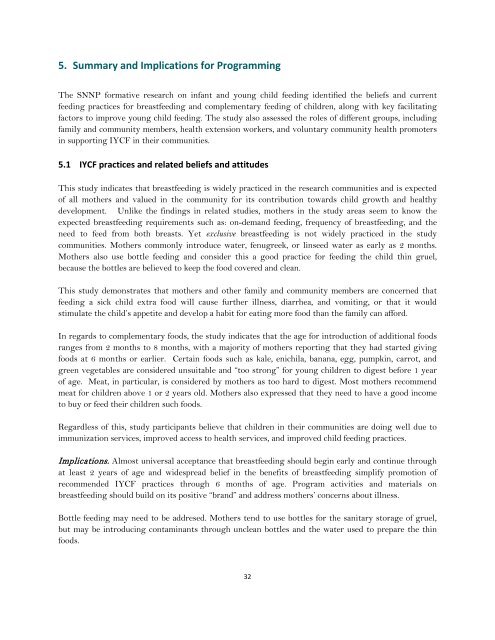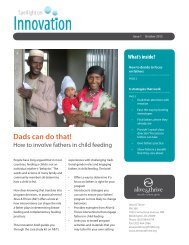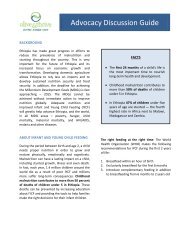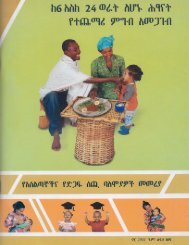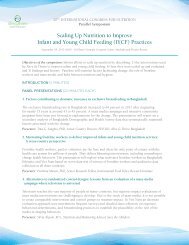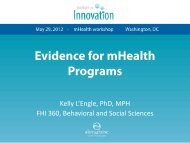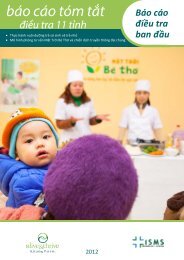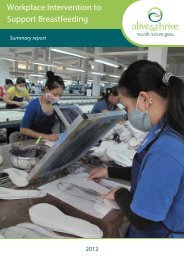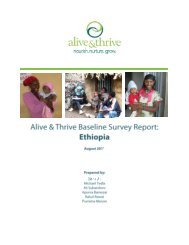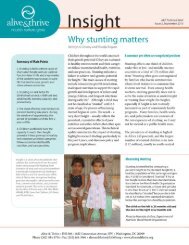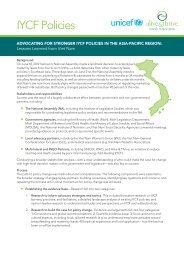IYCF Practices, Beliefs, and Influences in SNNP ... - Alive & Thrive
IYCF Practices, Beliefs, and Influences in SNNP ... - Alive & Thrive
IYCF Practices, Beliefs, and Influences in SNNP ... - Alive & Thrive
Create successful ePaper yourself
Turn your PDF publications into a flip-book with our unique Google optimized e-Paper software.
5. Summary <strong>and</strong> Implications for Programm<strong>in</strong>gThe <strong>SNNP</strong> formative research on <strong>in</strong>fant <strong>and</strong> young child feed<strong>in</strong>g identified the beliefs <strong>and</strong> currentfeed<strong>in</strong>g practices for breastfeed<strong>in</strong>g <strong>and</strong> complementary feed<strong>in</strong>g of children, along with key facilitat<strong>in</strong>gfactors to improve young child feed<strong>in</strong>g. The study also assessed the roles of different groups, <strong>in</strong>clud<strong>in</strong>gfamily <strong>and</strong> community members, health extension workers, <strong>and</strong> voluntary community health promoters<strong>in</strong> support<strong>in</strong>g <strong>IYCF</strong> <strong>in</strong> their communities.5.1 <strong>IYCF</strong> practices <strong>and</strong> related beliefs <strong>and</strong> attitudesThis study <strong>in</strong>dicates that breastfeed<strong>in</strong>g is widely practiced <strong>in</strong> the research communities <strong>and</strong> is expectedof all mothers <strong>and</strong> valued <strong>in</strong> the community for its contribution towards child growth <strong>and</strong> healthydevelopment. Unlike the f<strong>in</strong>d<strong>in</strong>gs <strong>in</strong> related studies, mothers <strong>in</strong> the study areas seem to know theexpected breastfeed<strong>in</strong>g requirements such as: on-dem<strong>and</strong> feed<strong>in</strong>g, frequency of breastfeed<strong>in</strong>g, <strong>and</strong> theneed to feed from both breasts. Yet exclusive breastfeed<strong>in</strong>g is not widely practiced <strong>in</strong> the studycommunities. Mothers commonly <strong>in</strong>troduce water, fenugreek, or l<strong>in</strong>seed water as early as 2 months.Mothers also use bottle feed<strong>in</strong>g <strong>and</strong> consider this a good practice for feed<strong>in</strong>g the child th<strong>in</strong> gruel,because the bottles are believed to keep the food covered <strong>and</strong> clean.This study demonstrates that mothers <strong>and</strong> other family <strong>and</strong> community members are concerned thatfeed<strong>in</strong>g a sick child extra food will cause further illness, diarrhea, <strong>and</strong> vomit<strong>in</strong>g, or that it wouldstimulate the child’s appetite <strong>and</strong> develop a habit for eat<strong>in</strong>g more food than the family can afford.In regards to complementary foods, the study <strong>in</strong>dicates that the age for <strong>in</strong>troduction of additional foodsranges from 2 months to 8 months, with a majority of mothers report<strong>in</strong>g that they had started giv<strong>in</strong>gfoods at 6 months or earlier. Certa<strong>in</strong> foods such as kale, enichila, banana, egg, pumpk<strong>in</strong>, carrot, <strong>and</strong>green vegetables are considered unsuitable <strong>and</strong> “too strong” for young children to digest before 1 yearof age. Meat, <strong>in</strong> particular, is considered by mothers as too hard to digest. Most mothers recommendmeat for children above 1 or 2 years old. Mothers also expressed that they need to have a good <strong>in</strong>cometo buy or feed their children such foods.Regardless of this, study participants believe that children <strong>in</strong> their communities are do<strong>in</strong>g well due toimmunization services, improved access to health services, <strong>and</strong> improved child feed<strong>in</strong>g practices.Implications. Almost universal acceptance that breastfeed<strong>in</strong>g should beg<strong>in</strong> early <strong>and</strong> cont<strong>in</strong>ue throughat least 2 years of age <strong>and</strong> widespread belief <strong>in</strong> the benefits of breastfeed<strong>in</strong>g simplify promotion ofrecommended <strong>IYCF</strong> practices through 6 months of age. Program activities <strong>and</strong> materials onbreastfeed<strong>in</strong>g should build on its positive “br<strong>and</strong>” <strong>and</strong> address mothers’ concerns about illness.Bottle feed<strong>in</strong>g may need to be addresed. Mothers tend to use bottles for the sanitary storage of gruel,but may be <strong>in</strong>troduc<strong>in</strong>g contam<strong>in</strong>ants through unclean bottles <strong>and</strong> the water used to prepare the th<strong>in</strong>foods.32


